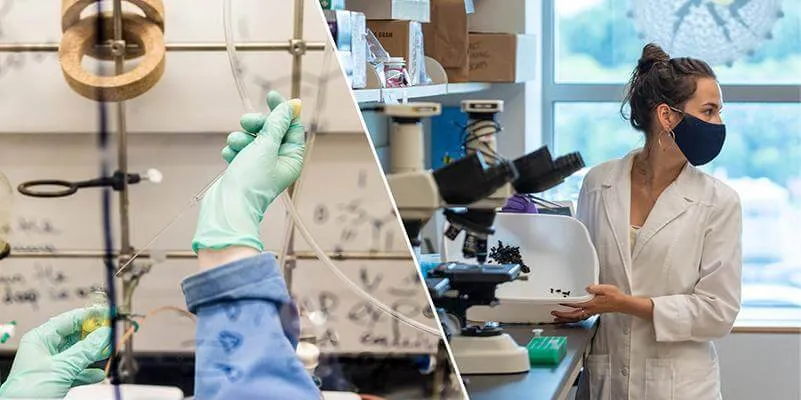In the pandemic, University of Vermont research expenditures hit record levels in 2020—up 41% to $191 million—to provide a crucial boost to Vermont’s economy during COVID-19.
The total was reported in UVM’s annual 2020 National Science Foundation Higher Education Research and Development survey and is the largest in the university’s history. It eclipses the previous record of $136 million by a wide margin, and is a key contributor to UVM’s overall $1.3 billion annual economic impact.
The expenditures flow from a range of sources, including over 650 research awards in 2020 targeting urgent societal needs across UVM’s two strategic research areas —“healthy societies” and “a healthy environment”—as outlined in the university’s strategic vision, Amplifying Our Impact.
“UVM researchers have shown their true mettle by exhibiting their excellence and dedication in pursuit of life-changing discoveries demanded especially during these difficult times,” said UVM President Suresh Garimella. “This tremendous growth in research—which benefits our community and our collective future—speaks to UVM’s strength and resiliency. And it showcases our commitment as Vermont’s flagship university, to seek solutions for the state, the nation and the world.”
Researchers garnered global attention for a range of UVM discoveries, from the creation of Xenobots, the world’s first living robots, to urgent new findings on Greenland’s ice sheet’s vulnerability to climate change. In total, UVM attracted 39 research awards of $1 million or more in 2020, including $10.4 million to study rural addictions, $8.4 million for sustainable agriculture research, and $2.2 million to address global infectious diseases. [Explore 2020 research awards.]
Supporting scholars
UVM has made significant investments in research infrastructure and systems to support scholars and streamline research proposal development, from adding grant writers to upgrading UVM’s supercomputing cluster. Seed grants, which help scholars to compete for larger external grants, also expanded. For example, the Gund Institute for Environment’s seed grant program has a 12-to-1 return on investment over three years.
“Research is central to what makes UVM a world-class institution,” said UVM Vice President for Research Kirk Dombrowski. “This growth in research is due to the success of UVM’s exceptional research community—faculty, postdocs, students and staff—in attracting funding and partnerships with government, industry and non-profit organizations for the pursuit of leading-edge discoveries and innovation.”
In 2020, UVM’s largest funders were federal agencies (nearly $100 million), particularly the National Institutes of Health, the National Science Foundation, and U.S. Dept. of Agriculture. This includes $7.1 million to address the COVID-19 crisis. Other major funders included: non-profit organizations ($8.5 million), the business sector ($3.6 million) and state government and local agencies ($1.1 million).
The Larner College of Medicine had the largest number of grants, but research awards were spread across UVM, including the College of Agriculture and Life Sciences, College of Arts and Sciences, Rubenstein School of Environment and Natural Resources, College of Engineering and Mathematical Sciences, College of Education and Social Services, and College of Nursing and Health Sciences.
Bringing skilled jobs to Vermont
The pandemic presented researchers with significant challenges. When COVID-19 hit, UVM quickly established COVID-19 Guidelines for Research for the safe continuation of the majority of campus research, and worked to reopen labs as early as late Spring. Still, global travel restrictions forced many scholars to adjust research plans, particularly for international research.
Despite these challenges, the role of research in Vermont’s economy remained substantial. The largest category of research expenditures—nearly $98 million—supported skilled employment in Vermont, including salaries and benefits for 2,300 faculty, students, technicians and other staff involved in research.
Towards “Research 1”
As UVM seeks to become a top tier research university, one key area of growth was research expenditures in non-STEM areas—including the humanities, social sciences, business, education—which grew to $12.3 million in 2020, also a record. Dombrowski said this growth is important as UVM prepares in the years ahead to apply for Carnegie Research 1 (R1) status, which would bring recognition, funding and other benefits to UVM and the state.
“Research benefits society and provides huge opportunities for our students,” said Dombrowski, who joined UVM in 2020. “To see our research efforts growing so significantly—and to watch our strategic investments so clearly bearing fruit—is extremely gratifying. I know that everyone in the Office of Research is proud of what the University has been able to accomplish during such a difficult year.”
Learn about UVM’s strategic vision, Amplifying Our Impact, and UVM research.
About the University of Vermont
Since 1791, the University of Vermont has worked to move humankind forward. UVM’s strengths align with the most pressing needs of our time: the health of our societies and the health of our environment. Our size—large enough to offer a breadth of ideas, resources, and opportunities, yet intimate enough to enable close faculty-student mentorship across all levels of study—allows us to pursue these interconnected issues through cross-disciplinary research and collaboration. Providing an unparalleled educational experience for our students, and ensuring their success, are at the core of what we do. As one of the nation’s first land grant universities, UVM advances Vermont—and the broader society—through the discovery and application of new knowledge.
UVM is derived from the Latin “Universitas Viridis Montis” (University of the Green Mountains)
